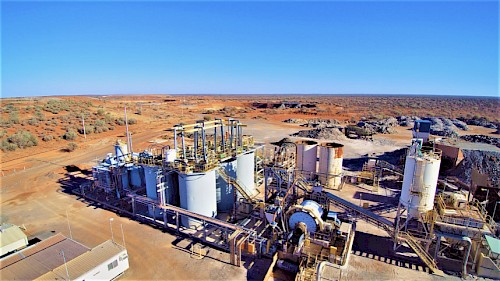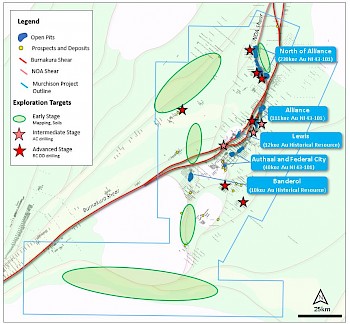Development
At Burnakura, Monument has a 260ktpa gold processing plant, that is on care & maintenance. A three-stage crushing circuit was rebuilt and refurbished and transported to the plant site.
Since the acquisition, extensive development work has been carried out to organise the site and upgrade camp facilities, including an expansion and upgrade of the onsite laboratory and construction of a new core shed, and drill core samples have been reorganized in preparation for geological inspection. Site accommodation and catering facilities are fully functional, have been used for exploration drilling and are ready for a potential re-start of production.
Geology
Most of the Burnakura Property area covers Archaean basement rocks assigned to the 2814-2800 Ma basal Norie Group of the Murchison Supergroup within the eastern margin of the Meekatharra-Wydgee greenstone belt. The Norrie group comprises: a thick succession of pillowed and massive tholeiitic basalts of the Murrouli Basalt; and conformably overlying felsic volcaniclastics with interbedded Banded Iron Formations (BIFs) and felsic volcanic rocks of the Yaloginda Formation.
The Burnakura gold deposits are situated along a northeast trending splay (Burnakura Shear Zone) that parallels and is linked to the north-northeast trending regional scale Mt Magnet fault. The Mt Magnet fault is the major east bounding structure to the “Meekatharra structural zone”, a major regional, northeast-trending shear dominated zone, about 50 to 60km wide, incorporating the Meekatharra area and extending through the Cue region as far south as Mount Magnet (Spaggiari, 2006). The Meekatharra structural zone is dominated by north and northeast-trending folds and shears, including refolded folds with approximately coplanar fold axes. Many of the folds are truncated by shears or faults, and the structural zone is interpreted as a major zone of shear-related deformation.
Gold mineralisation is thought to have extended from 2,660 to 2,630 Ma during predominantly strike-slip D4 shearing and coincident with the peak of granitic magmatism. The Burnakura Shear Zone gold mineralisation is typical of a brittle to semi-ductile shear zone forming semi-continuous dilational veins. The mineralisation is dominated by steep dipping quartz (±minor sulphides) veins orientated parallel to the foliation of the fault zone. Minor sulphides are present and little alteration of the host lithology is also observed.
Exploration
Since acquisition, drilling programs have focused on Burnakura, where multiple historical open pits and underground mines are situated. RC and diamond drilling has been completed by Monument for exploration purposes and also to convert and increase the historical resource to NI 43-101 resource standards.
Drilling has focused on the NOA, Alliance, New Alliance and Federal City deposits and included infill drilling as well as extensional drilling close to existing pits. A series of metallurgical holes were also drilled to support the resource classification. The drilling confirmed the continuity of mineralisation and highlighted the potential for future underground development at deposits including NOA 7/8, which has over 600m of high-grade strike length open at depth and to the north.
In July 2018 the Company released a NI 43-101 Report “Updated Mineral Resources, Burnakura Gold Project, Western Australia” produced by SRK Consulting, Perth, and filed on SEDAR. This report increased the Indicated Resources to 293koz from 98.4koz and increased the Inferred Resources to 88koz from 4.4koz. The 2018 Updated Mineral Resources have incorporated 46,847m of RC drilling and 1,797m of diamond drilling completed by Monument between 2014 and 2016 combined with over 180,000m of historical drilling.
Monument has completed the following exploration programs since the acquisition:
- A 3D structural study was completed in September 2019 which confirmed near-mine, down-plunge potential and highlighted regional prospectivity. The study was undertaken by principal structural geologists, Dr. Jun Cowan and Dr. Oliver Kreuzer (X-plore GeoConsulting).
- A 1,974m RCDD drill program was completed in May 2020 and included testing several targets that were identified in the 3D structural study. A total of 8 holes for 1,577m of RC and 397m of DD were drilled to test down plunge extensions of high-grade gold mineralization at Alliance (806m), New Alliance (557m), NOA 1 (264m) and NOA 2 (346m). The drill holes targeted high grade gold mineralization with the potential to be mined underground as part of Monument’s strategy to delineate additional resources.
- A total of 30 regional exploration targets were identified at the Burnakura project as part of a regional review. High-potential exploration targets include greenfield targets with no known first pass sampling and potential strike lengths of over 3km, and brownfield targets along strike from and adjacent to known deposits such as New Alliance and the NOA group.
- During FY2022 and FY2023 a two-phase exploration program at Burnakura was implemented to test high priority targets including underground at NOA 7/8 and NOA. The drill programs were planned in conjunction with deposit reviews and the modelling of new faults that control mineralisation. In addition, a greenfield exploration program was implemented to enable the early identification of potential new resources. Phase 1 RC and AC drill program results confirmed the discovery of new high-grade mineralization at the Junction Target (3m at 10.2g/t Au including 1m at 27.3g/t Au from 21BNAC213). Phase 2 RC drilling assays have encountered multiple mineralization horizons at depth, indicating gold mineralization down-dip and the potential for additional underground economic mineralization at the NOA 1 deposit (4m at 32.0g/t Au from 218m (including 1m at 71.8g/t Au from 219m), 1m at 1.1g/t Au from 226m, 1m at 4.2g/t Au from 229m and 1m at 1.1g/t Au in 21BNRC050). Phase 2 DD drilling assays confirmed the extension of gold mineralization, including high grades of up to 17.8g/t gold, for more than 150m vertical depth below the current Mineral Resource at the North of Alliance (“NOA”) group of deposits (NOA 1 to NOA 7/8, NOA9), offering the potential for significant future expansion of the Mineral Resource base.


